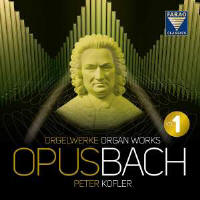Texte paru dans: / Appeared in: |
|
|
Reviewer: James
A. Altena
This set brings the start of
yet another complete Bach organ cycle on CD. The ever-useful “Bach Cantatas”
website, bach-cantatas.com/NVD/Organ-Complete.htm, lists 75 complete or
nearly complete cycles (in alphabetical order by performer) as of the most
recent update in July 2019, and that does not include several cycles
currently in progress. (About 12 or so listings appear to be announced
cycles that were abandoned after only a few entries.) Well-known
names—Alain, Bowyer, Chapuis, Fagius, Foccroulle, Herrick, Hurford, Isoir,
Jacob, Koopman, Preston, Rogg, Rübsam, Vernet, Walcha, and Weinberger—are
surrounded by a host of lesser figures. (I have Wolfgang Stockmeier’s
super-budget set, which in addition to the attractive price very sensibly
presents all the works in BWV order, making it an incredibly handy reference
tool. They’re solid performances, too, if not quite top-tier.) As past
readers of my foolscap know, Koopman’s cycle for me ranks above all the rest
as the standard by which all others are to be measured. This new cycle by Peter Kofler lays claim in its booklet essay (an interview with Kofler by Matthias Keller) to being distinctive in several ways. First, rather than grouping works together by genre, as most recorded cycles typically do, it presents mixed recitals of preludes and fugues, organ chorales, partitas, trio sonatas, and transcribed concertos. Personally, while I understand the rationale for so doing, I think that for a complete Bach organ set this is a miscalculation, because one main desideratum for owning such a set is reference purposes, which means being able to locate a piece with ease, something the scattershot approach of mixed recitals does not allow. Second, a deliberate choice was made to record the cycle on a modern instrument—the Rieger Organ of the Jesuitenkirche St. Michael in Munich—rather than a historic German Baroque instrument. I am of two minds about this. On the one hand, I love the sound of a historic organ such as a Silbermann, and to some degree miss it here. On the other hand, most of us can’t travel to Germany to listen to Bach live on such an instrument, and if one is persnickety enough to insist upon only listening to one of those, one would never hear Bach performed live—and of course even the best digital recording in the world doesn’t even begin to match having one’s whole body thrillingly vibrated by a live organ in a church. Also, this Rieger instrument is one of the best modern organs I’ve ever heard on a recording; it has no unpleasant electronic aftertaste to the sound, and is clearly in the historic German lineage, so it sounds authentic enough. Third, there is the new recording technology employed, Auro-3D, a “high-resolution 10.1 audio format” that has both vertical and horizontal sound layers. This last point is a specification for the indefinite future; at present there are no commercially available home playback systems for reproducing this (only a few recording studios and theaters have the technology in place), so you can’t hear that extra dimension yet on your home stereo or headphones. The performances themselves are quite commendable. Kofler plays with rock-steady tempos and rhythms, immaculately clean articulation, and well-judged choices of registrations, stops, and balances. His tempos are uniformly brisk, energetic, and well sprung, which is how I like to hear Bach. Also, he is completely unfussy and devoid of eccentricity, without ever being the slightest bit dull; he lets the music speak for itself without imposing his own personality upon it. Perhaps occasionally he seems just a bit business-like rather than inspired; but that may also be an effect of listening to extended portions of this set at a single stretch, and I’m sure there’s not a single organist who hasn’t found a few lesser pieces of Bach to be more workmanlike than inspired (though you could never prove it by me). The recorded sound is top-notch, capturing everything faithfully; the discs are all generously filled. The booklet includes an artist bio and organ specifications in addition to the interview. About the only thing I don’t like here is the graphic design for the cardboard clamshell box and disc sleeves of a Bach organ bust foregrounded in front of organ pipes shaded in psychedelic colors. In sum, the more I listen to this set, the more I like it; it leaps to near the front of the line, ahead of many others, and when complete promises to compete with Masaaki Suzuki’s ongoing series as a prime choice for a new Bach organ cycle. I look forward to receiving the subsequent installments. Very highly recommended. | |
|
|
|
|
|
|
|
Cliquez l'un ou l'autre
bouton pour découvrir bien d'autres critiques de CD |
|




